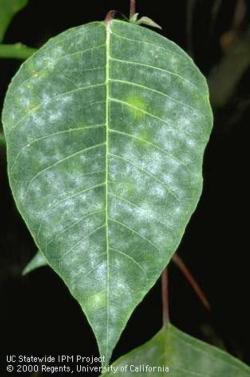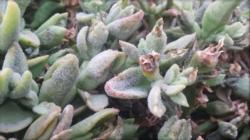Powdery and Downy Mildews
by Jim Downer
Two kinds of “mildew” foliage diseases are commonplace in nurseries but are very different from each other biologically. While both kinds of disease cause damage and symptoms on the new growth, foliage and young stems of ornamental plants, the biology and thus control of these diseases are very different. Both pathogen groups are similar in that they parasitize living plants and generally are difficult to grow in culture plates, preferring a living host rather than artificial media for their growth. Powdery mildews are more common but we are seeing an insurgence of new downy mildews in the ornamental plants.
Powdery mildews are plant pathogens attacking over 10,000 species of plants and belonging to more than 1600 genera of fungi in the classAscomycetes. ManyAscomycetes including most powdery mildews are “compound interest” diseases meaning that they have two spore production phases: a sexual stage that usually supplies the primary (first infectioninoculum) and a secondaryconidial stage that produces asexual spores. Theconidial stage is what we recognize as powdery mildew (fig. 1).

Since all of the mildew spores look very similar mycologists called this part of the life cycle Oidium or the Oidial stage. Modern molecular biology techniques have helped identify and reclassify mildews that have never formed the sexual stage. The sexual part of the life cycle involves production of ascospores in fallen leaves inside a structure called a cleistothecium. Sexual spores are released in the spring during wet periods and are wind and splash borne onto new tissues where the first infections occur resulting in the mildew or conidial stages that can continue to reinfect all season long on new growth. Powdery mildew conidia only infect living tissues of epidermal cells and do not penetrate to deeper layers. They are obligate parasites or biotrophs, which require living host cells to grow in. Infection results in impaired growth, often resulting in cupped, curled or distorted foliage. These fungi can infect in moderately humid or even dry conditions. Free water is not necessary. In fact the severity of powdery mildews is decreased in wet weather or when free moisture covers leaf surfaces. During periods of high rainfall other fungal pathogens become more important, especially the downy mildews.
Downy mildews are actually foliage blights. Downy mildew diseases are caused by organisms in the class Oomycetes and related to Pythium and Phytophthora, so as such are not members of the fungal Kingdom but a newly erected Kingdom called the Chromalveolata. All downy mildew species are members of the Peronsosporaceae family and are obligate parasites of higher plants. Downy mildews have complicated and variable lifecycles. They are also compound interest diseases with a sexual stage forming oospores in the leaf cortex that germinate to form sporangia which release zoospores in fallen leaf litter. Infected living plant surfaces also generate sporangiophores that give rise to sporangia and release more zoospores. In some downy mildews, sporangia germinate directly rather than forming a germ tube. Unlike powdery mildews, sporangia form on the underside of leaves, not on upper surfaces. Sporangia formation and disease progression are favored by cool or warm wet conditions but not by hot weather. Free water and high humidity are necessary to the life history of this organism and favor disease development. Recently a new disease caused by Peronsopora mesembryanthemi has spread rapidly on Aptenia cordefolia or red apple ice plant (fig. 2).
Fig. 2. Downy Mildew on Aptenia cordefolia. Photo: Jose Rodrigues, Waypoint Analytical Labs.

Other common ornamental hosts include alyssum, snapdragon and rose. Unlike powdery mildews, downy mildews invade leaves and stems beyond the epidermis and kill host tissues, often rapidly during wet weather. While early symptoms can look “mildew-like,” established downy mildew infections usually lead to necrotic and blighted tissues. Also unlike powdery mildew conidia, downy mildew sporangia are gray-brown in appearance.
Powdery mildews are controlled by a broad range of prophylactic and systemic fungicides. However early applications are advocated because fungicides that eradicate or kill the target fungus will also kill the plant cells it has invaded leading to phytotoxicity as well as control. It is best to control the disease early during spore germination, germ tube elongation or pre-penetration phases of development. Wetting leaf surfaces or increasing leaf wetness can also give some limited control, so inclusion of a wetting agent or surfactant (alone or with a fungicide) can control many of these diseases. Downy mildews are controlled by the same materials that control root rots caused by Pythium and Phytophthora, so phosphorus acid materials, mefanoxam and other pesticides that control Oomycetes can limit downy mildew formation. Increasing leaf wetness will make downy mildew diseases worse. Generally hot and dry conditions and dry foliage favor control.
References
Agrios GN. 2005. Plant Pathology 5th ed. Elsevier Academic Press. Burlington MA, USA.
Scheck H, Chitambar J, Dara SK. 2016. Reporting downy mildew of ice plants in California. Pest News. http://ucanr.edu/blogs/blogcore/postdetail.cfm?postnum=20558.












